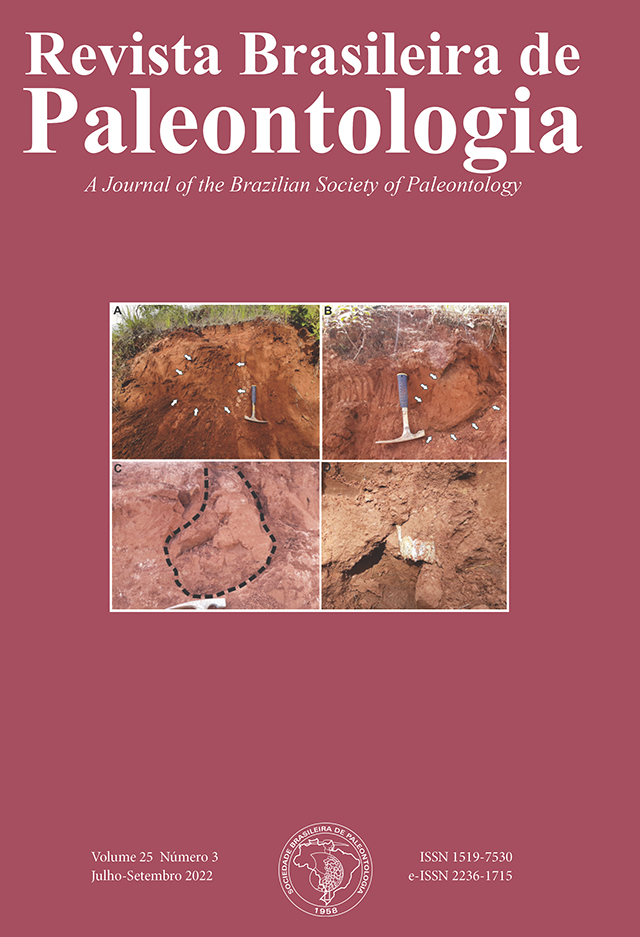Stratigraphy of the Thanetian rotaliids limestone, northern Lorestan, Iran - Lorestan, SW Iran
DOI:
https://doi.org/10.4072/rbp.2022.3.02Resumo
In this research, biostratigraphy of the Taleh Zang Formation, located in northern Lorestan, SW Iran, is discussed. The benthic foraminiferal contents of the upper Paleocene successions were examined in a carbonate platform setting in the context of European standard zonation (Shallow Benthic Zones). The co-occurrence of Glomalveolina levis (Hottinger) and Miscellanea miscella (d’Archiac & Haime) characterizes Zone SBZ 4, indicating a Thanetian age. Based on biofacies analysis and faunal associations, with emphasis on benthic foraminifera and coralline red algae, tidal flat and marginal marine environment exposed to salinity fluctuations (short-term salinity fluctuations or fully marine conditions), dominated by small benthic Foraminifera (Kathina) with slightly mesotrophic conditions, are determined for the deposition of the Poshte Jangal section. The highly translucent, shallowest part of the inner shelf dominated by representatives of Miscellanea and Opertorbitolites. The biotic assemblages representing warm tropical waters with oligotrophic conditions were observed in Palganeh and Pasan sections.
Keywords: Taleh Zang Formation, Paleocene, Foraminifera, Biostratigraphy, Thanetian.
RESUMO – Nesta investigação, discute-se a biostratigrafia da Formação Taleh Zang, localizada no norte de Lorestan, sudoeste do Irã. Os foraminíferos bentônicos das sucessões do Paleoceno superior foram examinados numa plataforma de carbonato no contexto da zonação padrão europeia (Shallow Benthic Zones). A coocorrência de Glomalveolina levis (Hottinger) e Miscellanea miscella (d’Archiac & Haime) caracteriza a Zona SBZ 4, indicando uma idade Thanetiana. Com base na análise de biofácies e associações faunísticas, com ênfase em foraminíferos bentônicos e algas vermelhas coralinas, ambiente marinho plano e marginal exposto a flutuações de salinidade (flutuações de salinidade a curto prazo ou condições totalmente marinhas), dominadas por pequenos foraminíferos bentônicos (Kathina) com condições ligeiramente mesotróficas, são determinadas para a deposição da seção Poshte Jangal. A parte mais superficial e altamente translúcida da plataforma interna é dominada por representantes de Miscellanea e Opertorbitolites. As associações bióticas representando as águas tropicais quentes com condições oligotróficas foram observadas nas seções de Palganeh e Pasan.
Palavras-chave: Formação Taleh Zang, Paleoceno, Foraminifera, biostratigrafia, Thanetiano.
Downloads
Downloads
Publicado
Como Citar
Edição
Seção
Licença
Copyright (c) 2022 Revista Brasileira de Paleontologia

Este trabalho está licenciado sob uma licença Creative Commons Attribution 4.0 International License.
This is an Open Access article distributed under the terms of the Creative Commons Attribution-NonCommercial-NoDerivatives license (http://creativecommons.org/licenses/by-nc-nd/4.0), which permits non-commercial re-use, distribution, and reproduction in any medium, provided that no alterations are made and the original article is properly cited. The written permission of Revista Brasileira de Paleontologia must be obtained before any commercial use and/or adaptation of the article.







